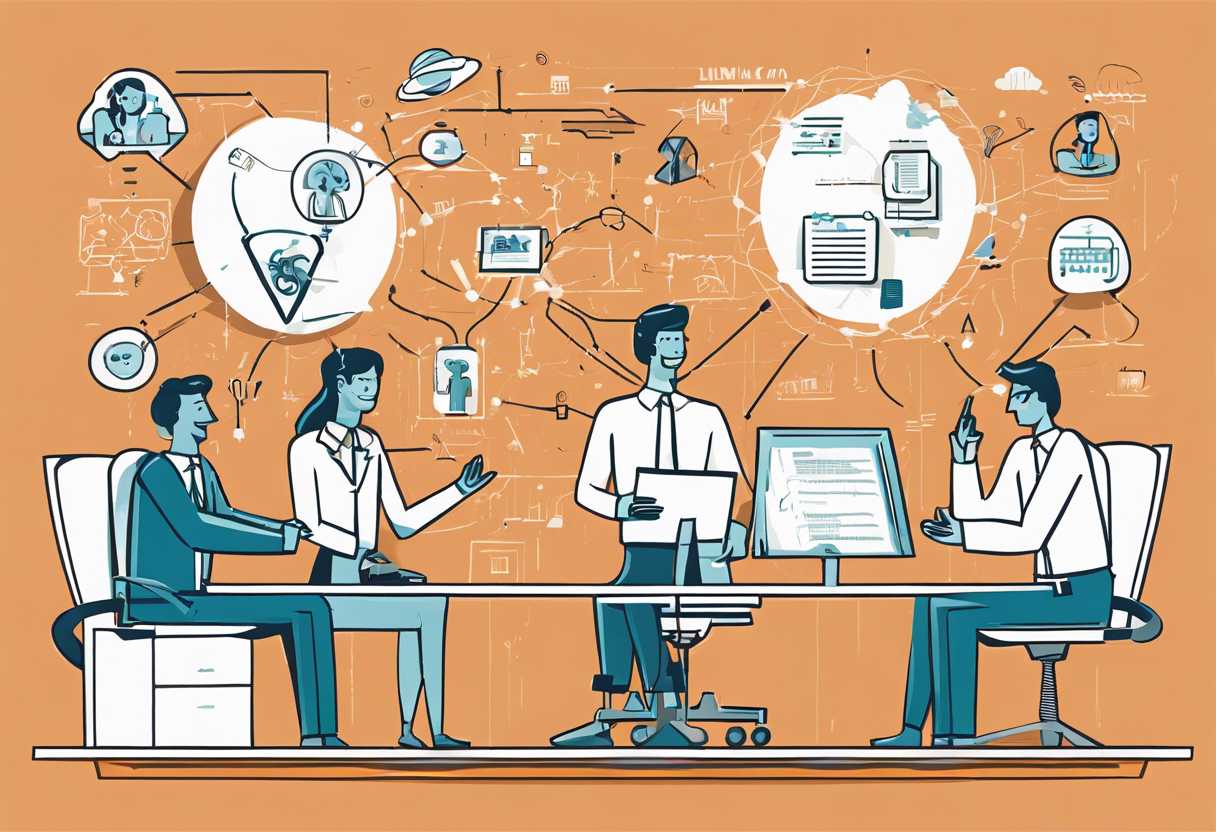Effective team communication is the cornerstone of any successful organization. It is the key to building a strong foundation for collaboration, problem-solving, and productivity. In this comprehensive guide, we will explore the essential strategies and tools for improving team communication, overcoming common challenges, and fostering a culture of open and transparent communication within your team.
Building a Strong Foundation: Understanding the Importance of Effective Team Communication
Effective team communication is more than just exchanging information. It is about understanding, listening, and responding to the needs of your team members. We will delve into the importance of clear and concise communication in building trust, fostering teamwork, and achieving common goals.
Key Strategies for Improving Team Communication and Collaboration
Communication breakdowns can hinder the progress of any team. We will discuss practical strategies for enhancing communication and collaboration, including active listening, setting clear expectations, and leveraging effective communication tools.
Overcoming Common Communication Challenges in a Team Setting
Miscommunication, conflicts, and misunderstandings are common challenges in a team environment. We will address these issues and provide actionable tips for resolving conflicts, managing difficult conversations, and promoting a positive communication culture.
The Role of Technology in Enhancing Team Communication and Productivity
Technology plays a crucial role in modern team communication. We will explore the latest tools and platforms that can streamline communication, facilitate remote collaboration, and boost overall productivity.
Cultivating a Culture of Open and Transparent Communication within Your Team
A culture of open and transparent communication is essential for fostering trust and accountability within a team. We will discuss practical ways to promote open dialogue, encourage feedback, and create a supportive communication environment.
By the end of this guide, you will have a comprehensive understanding of the key principles and best practices for effective team communication. Whether you are a team leader, manager, or individual contributor, this guide will equip you with the tools and knowledge to enhance communication within your team and drive success.
Building a Strong Foundation: Understanding the Importance of Effective Team Communication
The Impact of Effective Team Communication
Effective team communication is the cornerstone of any successful organization. When team members are able to communicate clearly and openly, it leads to increased productivity, better problem-solving, and a more positive work environment. Studies have shown that organizations with strong communication practices are 50% more likely to have lower employee turnover rates. This highlights the significant impact that effective team communication can have on the overall success of a business.
Barriers to Effective Team Communication
Despite the importance of effective team communication, there are several common barriers that can hinder it. These barriers can include poor listening skills, cultural differences, language barriers, and lack of trust among team members. It’s crucial for organizations to identify and address these barriers in order to foster a culture of open and effective communication within their teams.
Strategies for Improving Team Communication
There are several strategies that organizations can implement to improve team communication. These can include regular team meetings, clear and concise communication channels, active listening training, and the use of collaboration tools to facilitate communication among team members. By prioritizing and investing in effective team communication, organizations can create a more cohesive and productive work environment.

Key Strategies for Improving Team Communication and Collaboration
Implementing Clear Communication Channels
One of the most important strategies for improving team communication and collaboration is to establish clear communication channels. This includes setting up regular team meetings, utilizing project management tools, and creating a culture of open communication. By ensuring that everyone knows how and when to communicate, teams can avoid misunderstandings and work more efficiently.
Encouraging Active Listening
Active listening is a crucial skill for effective team communication and collaboration. Encouraging team members to actively listen to one another can help prevent miscommunication and foster a more collaborative environment. This can be achieved through training and team-building exercises that focus on improving listening skills.
Utilizing Technology for Collaboration
Technology plays a vital role in improving team communication and collaboration. By using tools such as project management software, video conferencing, and instant messaging platforms, teams can work together more effectively, regardless of their physical location. These technologies can also help streamline communication and ensure that everyone is on the same page.

Overcoming Common Communication Challenges in a Team Setting
Establishing Clear Expectations
One of the most common communication challenges in a team setting is the lack of clear expectations. This can lead to confusion, frustration, and ultimately, a breakdown in teamwork. To overcome this challenge, it’s essential to establish clear expectations from the outset. This means clearly defining roles and responsibilities, setting goals and deadlines, and communicating openly about what is expected from each team member. By doing so, you can minimize misunderstandings and ensure that everyone is on the same page.
Encouraging Open and Honest Communication
Another common challenge in a team setting is the lack of open and honest communication. This can lead to unresolved conflicts, unaddressed concerns, and a lack of trust within the team. To overcome this challenge, it’s important to create a culture of open communication where team members feel comfortable expressing their thoughts and opinions. This can be achieved through regular team meetings, one-on-one check-ins, and the use of tools such as anonymous feedback forms. By encouraging open and honest communication, you can foster a more collaborative and supportive team environment.
Leveraging Technology for Effective Communication
In today’s digital age, technology plays a crucial role in facilitating communication within a team. However, choosing the right communication tools and ensuring that team members are proficient in using them can be a challenge. To overcome this, it’s important to select communication tools that align with the team’s needs and preferences, whether it’s email, instant messaging, video conferencing, or project management software. Additionally, providing training and support to team members can improve their proficiency in using these tools and enhance overall communication efficiency.
The Role of Technology in Enhancing Team Communication and Productivity
Improved Collaboration with Remote Teams
With the rise of remote work, technology has played a crucial role in enabling teams to collaborate effectively regardless of their physical location. Tools such as video conferencing, instant messaging, and project management software have made it possible for team members to communicate in real-time, share documents, and collaborate on projects seamlessly. This has not only improved communication but has also increased productivity by allowing teams to work together efficiently, regardless of their geographical location.
Streamlined Workflow with Task Management Tools
Task management tools have revolutionized the way teams organize and prioritize their work. By using these tools, team members can assign tasks, set deadlines, and track progress in a centralized platform. This not only helps in keeping everyone on the same page but also ensures that no task falls through the cracks. Additionally, these tools often come with features such as file sharing, comments, and notifications, which further enhance team communication and productivity by providing a clear overview of the workflow and facilitating seamless collaboration.
Enhanced Productivity with Automation and Integration
Technology has also introduced automation and integration capabilities that have significantly boosted team productivity. By automating repetitive tasks, teams can save time and focus on more strategic activities. Moreover, integration between different tools and platforms allows for a seamless flow of information, eliminating the need for manual data entry and reducing the risk of errors. This not only streamlines processes but also ensures that teams can access the information they need, when they need it, ultimately enhancing their productivity.
Cultivating a Culture of Open and Transparent Communication within Your Team
The Importance of Open Communication
Open communication within a team is crucial for fostering trust, collaboration, and productivity. When team members feel comfortable expressing their thoughts and ideas, it leads to better problem-solving, innovation, and overall job satisfaction. *Encouraging open communication also helps to prevent misunderstandings and conflicts, leading to a more harmonious work environment.*
Building Trust through Transparency
Transparency is key to building trust within a team. When leaders and team members are transparent about their actions, decisions, and goals, it creates a sense of accountability and reliability. *Transparency also helps to align everyone’s efforts towards a common purpose, leading to a more cohesive and motivated team.*
Practical Strategies for Fostering Open and Transparent Communication
- Regular team meetings to discuss progress, challenges, and goals.
- Implementing an open-door policy where team members feel comfortable approaching leaders with their concerns or ideas.
- Utilizing communication tools such as instant messaging, project management platforms, and email for transparent and accessible communication.
- Encouraging feedback and constructive criticism to promote open dialogue and continuous improvement.
Conclusion
Effective team communication is the cornerstone of a successful and productive work environment. By understanding the importance of clear and open communication, implementing key strategies for improvement, and leveraging technology to enhance collaboration, teams can overcome common challenges and foster a culture of transparency and trust.
Building a strong foundation for effective team communication starts with recognizing the value of clear and open dialogue. By prioritizing active listening, empathy, and understanding, teams can create a supportive and inclusive environment where everyone feels heard and valued.
Key strategies such as setting clear goals, establishing regular check-ins, and promoting open feedback can significantly improve team communication and collaboration. Overcoming common communication challenges, such as misinterpretation and conflict, requires proactive measures and a commitment to continuous improvement.
Technology plays a crucial role in enhancing team communication and productivity. By leveraging tools and platforms that facilitate seamless collaboration, teams can streamline their workflows and stay connected, regardless of their physical location.
Cultivating a culture of open and transparent communication within your team requires ongoing effort and commitment. By fostering an environment where everyone feels comfortable sharing their thoughts and ideas, teams can harness the collective intelligence and creativity of their members.
As you strive to enhance team communication within your organization, remember that effective communication is a journey, not a destination. By continuously refining your approach and embracing new tools and techniques, you can create a work environment where collaboration thrives, and productivity soars.
Take the first step towards improving team communication today, and watch as your team becomes more cohesive, efficient, and successful.

